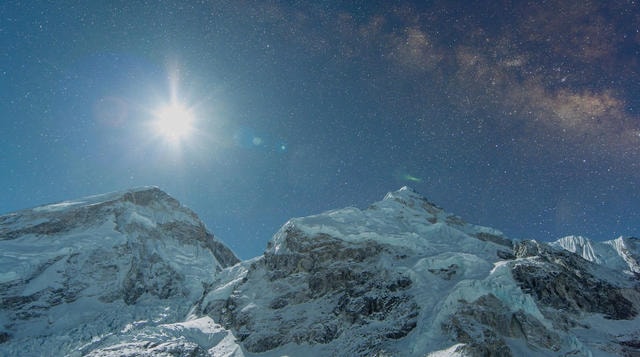Mount Everest, the tallest and most famous mountain in the world attracts an increasing number of climbers, some of them being highly experienced mountaineers. There are two main routes, from Nepal and from Tibet – and while these routes don’t pose a substantial technical climbing challenge, not everyone reaches the summit. Harsh weather conditions, altitude sickness and avalanche hazards are some of the main reasons that stop climbers.
Award-winning filmmaker and photographer Elia Saikaly has been on seven Everest expeditions, failed twice just before the top, survived two avalanches and an earthquake and stood on the top of the world twice, in 2010 and 2013. He began his adventure filmmaking career on the slopes of Mt. Everest, where he set out to honour the life of his fallen mentor:
In 2005, I embarked on a journey to Mt. Everest basecamp as young aspiring adventure filmmaker. I’d never really traveled, I’d never visited a 3rd world country and I had never even slept in a tent. That first journey to Nepal changed everything. My friend Dr. Sean Egan, who was aspiring to become the oldest Canadian to climb to the highest point on Earth, who also happened to be the subject of the documentary I was shooting, tragically died of heart failure and never made it to the summit of Everest. It was shocking and devastating. In an attempt to honour his life I decided, never having climbed a mountain before, that I was going to climb Everest in his honour, carry his ashes to the summit and complete the documentary.
The next five years were the most difficult, emotional and life altering time in Elia’s life. In 2010, he decided it was time to make the plunge into the world of DSLR filmmaking, being quite nervous to change his technical equipment. His expeditions and filmmaking now create positive change in the lives of communities across the world.
Everest – A Time Lapse Film – II is a tribute to the top of the world, a result of 108 total time-lapses and set ups over two years in the Himalayas – with 44,069 still images created. Some of the featured places include the Summit of Mt. Lobuche East, Camp 1 and 2 on Mt. Everest, Khumjung Village. Shooting is difficult in conditions this harsh: batteries, cameras and shutters freeze; the environment is challenging for the human body, too. And yet, for Elia, this is the perfect place where he feels the most alive, confessing that he has never seen the Milky Way so clear and vivid:
We slept at 6000m for three consecutive nights on the summit of Mt. Lobuche East waiting for a glimpse of Everest from that vantage point. Around 11pm on the 2nd night, the skies opened up and the top of the world revealed herself in all of her glory.
We all can now enjoy this breathtaking view. The time lapse features powerful images combining man-made structures, majestic landscapes, star trails and the re-emerging sun in a set of clear and sharp pictures underlined with string music, namely The Time To Run by Dexter Britain. All images were shot on Canon DSLR cameras with 24mm, 14mm, 16mm, 11-24mm and 70-200mm lenses. The material was edited with Adobe Lightroom, LR Time-Lapse and Adobe Premiere.
Another impressive fact was shared by the author: all of the images were processed on location while at Mt. Everest basecamp at night, under a headlamp, with a down-jacket on and in -25 °C temperatures. Enjoy the result of this project!

Everest - A Time Lapse Film - II
Follow Elia Saikaly on his Vimeo channel | Facebook | Instagram | Twitter | website.
Do you have a video you think we should feature, or is one of your friends a talented filmmaker? Submit your work at marketing@foliovision.com for a chance to be featured in our Video of the Week series!
DT00SK

Leave a Reply